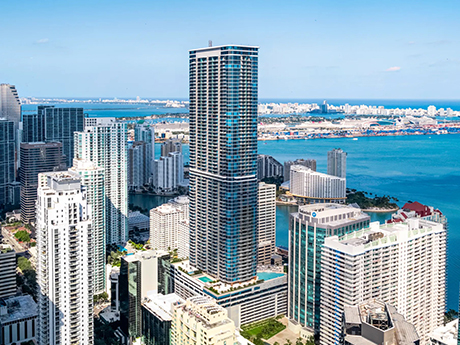Miami’s multifamily sector was on fire from the end of 2020 through the beginning of 2023 as the market received a wave of newcomers, primarily from affluent Northeastern and Western states. During the height of the pandemic, roughly $1 out of every $6 in income that moved nationwide relocated to Florida, more than any other state. And Miami-Dade County saw the second highest inflows of any county in the country behind only Palm Beach, two counties to the north of Miami-Dade.

This influx resulted in tremendous rent growth, booming new development and record-setting sales. The period also marked dozens of corporate expansions and relocations to the area and a consistent sub-3 percent unemployment rate dating back to August 2022, which is below today’s 3.8 percent national rate.
Since then, things have slowed down, though the epic in-migration of wealth has made a permanent impact.
Miami’s multifamily fundamentals stand out as a beacon of resilience amid supply challenges across the Sun Belt. Infill rents have remained flat since 2022, notching slight increases in 2024, and occupancy has faltered only slightly. This is rarely celebrated, but in this case, it represents Miami’s unique strength.
Demand also emerged for a higher caliber of multifamily product by renters willing to pay. This phenomenon is best seen in the “shadow” condo rental market and larger units at best-in-class, purpose-built rental properties. Miami Beach’s luxury condo rents, for example, reached new all-time highs with rents surpassing $6 to over $10 per square foot and per-unit rents from $6,000 for one- and two-bedroom units to over $25,000 for three-plus bedrooms. In Brickell, premier condo rents are anywhere from $6 to $9 per square foot, with per-unit rents frequently surpassing $15,000.

As for professionally managed apartments, historically rents on a per square foot basis have been highest for smaller units and lowest for larger units. Today, at Miami’s premier rental properties including Bezel at Miami Worldcenter, Solitair Brickell and Panorama Tower, they are now directly in line in the low- to mid-$5 per square foot range, with monthly rents as high as $5,000 to over $10,000 per month for larger units. For perspective, average rents in Miami in early 2024 in the “four and five star” category were $3.06 per square foot, or $2,858 per unit.
Increasing supply, however, presents challenges to these strong market fundamentals, at least in the near-term. Net absorption of 7,780 apartments through third-quarter 2023 lagged net deliveries of 13,388 units, resulting in a decline in occupancy.
Additionally, annual rent gains have slowed to 1.9 percent, down from the five-year historical average growth of 5.4 percent. Investment sales activity has also decreased with 2023 Class A multifamily transactions falling 83 percent year-over-year and 37 percent for Class B and C properties.

Falling victim to higher interest rates, cap rates on multifamily acquisitions increased nearly 200 basis points to about 5.25 percent or higher, and average trade values fell below $300,000 per unit. Institutional owners nonetheless see long-term value given the area’s strong fundamentals and have little pressure to sell.
Despite setbacks, with rent growth decelerating and occupancy expected to dip temporarily, there is unmet demand at the high-end, and developers are responding. The 124-unit Regency Parc in Coral Gables is a good example as it will target those who appreciate the best quality finishes and amenities available anywhere, with larger floor plans and in a professionally managed rental property without the burden of homeownership. More developers are expected to cater to this emerging niche of boutique-style rental projects.
As for the development pipeline, projects are happening, but there are few new construction starts. Higher interest rates have increased the minimum required yield for development, and effectively paused much of the new multifamily development. Combined with escalating construction and insurance costs, many projects are no longer economically feasible. This is a national phenomenon, with the Census Bureau indicating a 44 percent year-over-year decline in U.S. multifamily construction starts as of March 2024.
Last year, Miami continued to experience strong development activity despite a dip in annual construction starts to approximately 7,900. This is likely residual momentum from the breakneck activity in prior years. A record-setting 15,100 units were initiated in 2022, following an already elevated level in 2021 totaling 11,000 units.
The next 24 months of development deliveries are more than quadruple the number of units delivered in the prior eight quarters and threaten to undermine the stable rents and occupancy the market has enjoyed. Anecdotal reports of anemic first-quarter 2024 leasing velocity at new projects speak to the difficulty of digesting new supply.
Many are hopeful, though, for more favorable market conditions and softened interest rates, and, either way, more deals should come to market in the latter half of this year to reinvigorate investment sales. Deliveries should also peak in 2025 with the opportunity to deliver new multifamily product into undersupplied submarkets with minimal competition in 2026 and 2027.
— By Robert Kaplan (executive managing director), Chris Lentz (executive director) and Mark Rutherford (director) of Cushman & Wakefield. This article originally appeared in the May 2024 issue of Southeast Real Estate Business.


